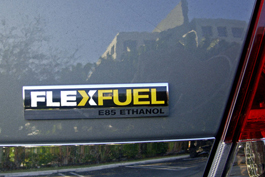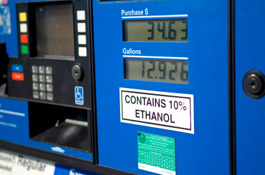Ethanol is added to gasoline
Typical E85 badge used to identify flexible fuel vehicles in the United States

Most of the gasoline now sold in the United States is blended with some amount of fuel ethanol. These blends are named by their ethanol content. For example, a blend of 10% fuel ethanol and 90% gasoline (by volume) is known as E10 gasoline. In 2017, about 14.4 billion gallons of fuel ethanol were consumed in the United States, nearly all in mixtures of E10 gasoline or less.
Any gasoline-powered engine in the United States can use E10, but only specific types of vehicles can use mixtures containing more than 10% ethanol. Because ethanol contains approximately 67% of the energy content of gasoline per gallon, use of ethanol blends results in decreased vehicle fuel economy (miles traveled per gallon). Vehicle fuel economy may decrease by about 3% when using E10.
Government policies help boost ethanol use
Ethanol was one of the first automotive fuels in the United States. With the exception of the two world wars, only small amounts of fuel ethanol were used until the 1970s. The oil embargo against the United States by major oil producers in the Middle East in 1973 and increases in oil prices in the late 1970s and early 1980s spurred interest in fuel ethanol as a way to reduce U.S. oil imports that had to be refined into gasoline. Various state and federal government policies and programs dating as far back as the mid-1970s have led to increased ethanol use in gasoline. About two million gallons of fuel ethanol were used in 1981, and about 14 billion gallons were used in 2017.
In 2011, with the U.S. ethanol industry well established and because of concerns about the federal budget deficit, the U.S. Congress let a 45-cent-per-gallon tax credit for ethanol blenders and a 54-cent-per-gallon tariff on ethanol imports expire at the end of 2011. The tax credit for blenders had been available for three decades.
Ethanol use increased significantly in 2002 as states began to ban the use of the gasoline oxygenate known as methyl tertiary butyl ether (MTBE) because of concerns that it contaminated groundwater. Ethanol quickly replaced MTBE as a gasoline oxygenate across the country. Ethanol use also increased after Congress passed the Renewable Fuel Standard (RFS) requirements under the Energy Policy Act of 2005 and then expanded and extended the RFS under the Energy Independence and Security Act of 2007. The RFS requires U.S. renewable fuel use to increase annually until it reaches 36 billion gallons by 2022.
The RFS targets were based on the assumption that U.S. gasoline consumption will increase over time so more ethanol can be blended with gasoline without hitting the E10 blend wall. The blend wall is the maximum ethanol blend that will not damage the engines and fuel systems of vehicles that can't use a gasoline-ethanol blend higher than E10. Gasoline consumption in recent years has been close to the E10 blend wall level. Fuel ethanol consumption in 2017 was nearly equal to 10% of total U.S. motor gasoline consumption.
The U.S. Environmental Protection Agency (EPA) administers the Renewable Fuel Standard and is developing processes and procedures on how ethanol blends greater than E10 can be sold. The EPA ruled in January 2011 that E15 can be used in cars and light trucks built after the 2001 model year without causing damage to the engine and fuel system. The EPA also approved a new E15 label for gasoline pumps so consumers know what fuel they are buying.
Flexible fuel vehicles can run on fuel blends up to E85
Although almost any regular gasoline car can run on blends of ethanol up to E10, only flexible fuel vehicles (FFV) can operate with E85 gasoline—a blend containing between 51% and 83% ethanol by volume. Flexible fuel vehicles are currently available from every major U.S. automobile manufacturer at no extra cost and are almost identical to regular gasoline vehicles, with the exception of a few modifications to the fuel system and minor engine components. About 3,300 fueling stations in the United States sell E85 to the public.







